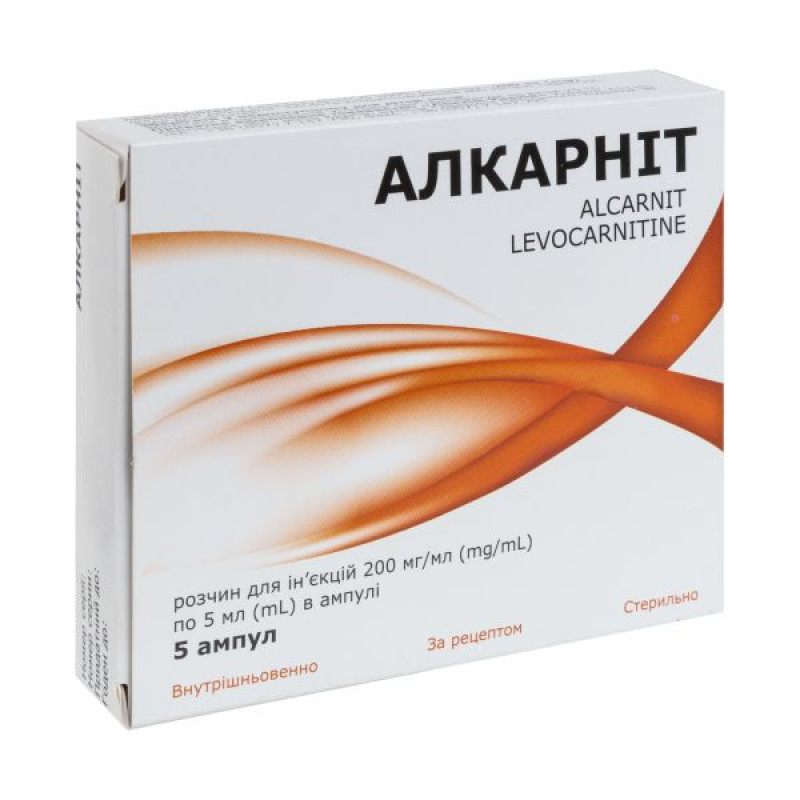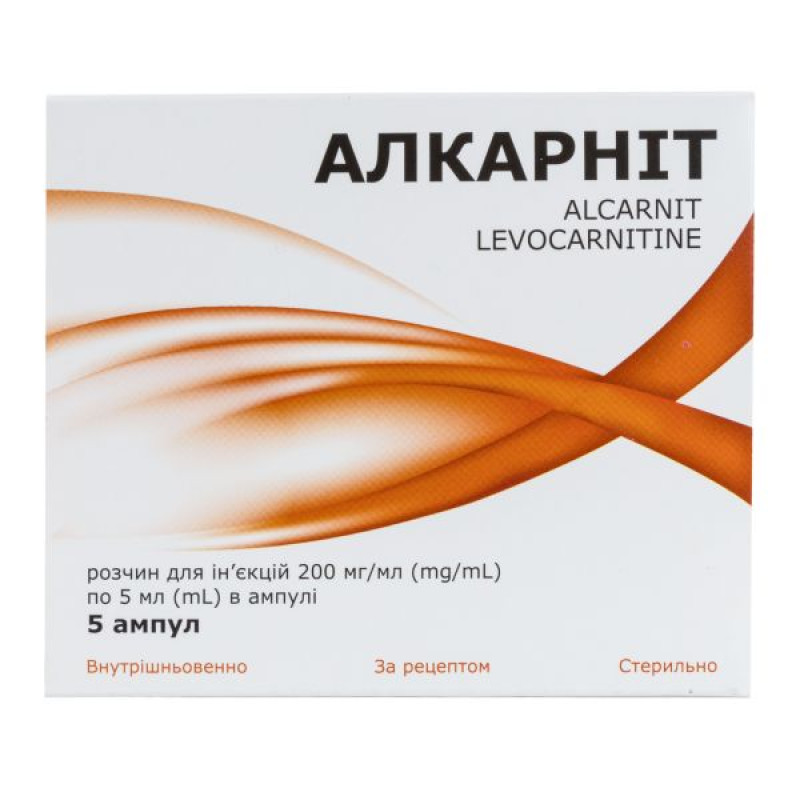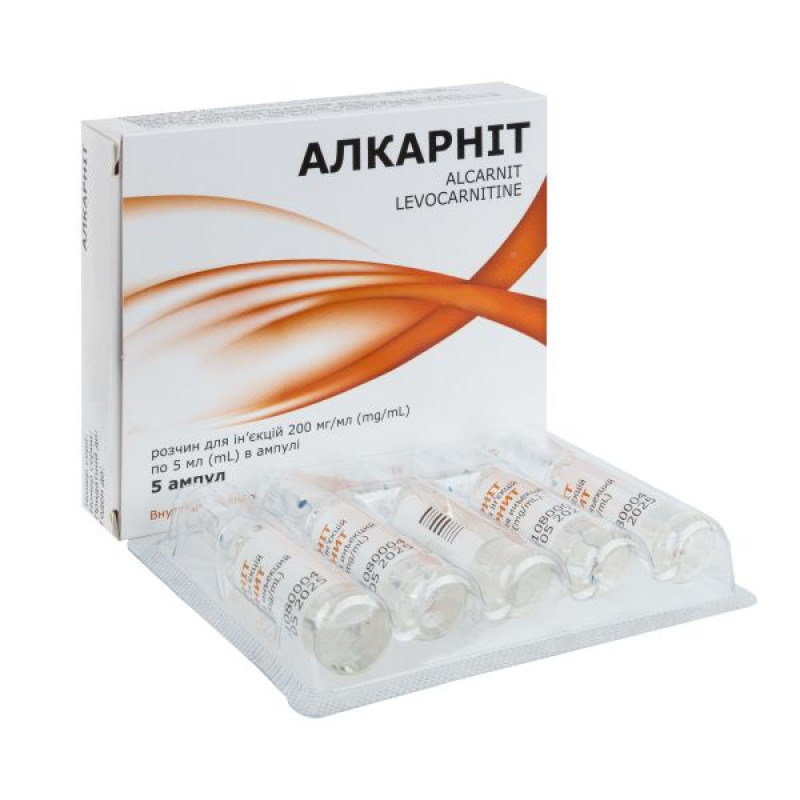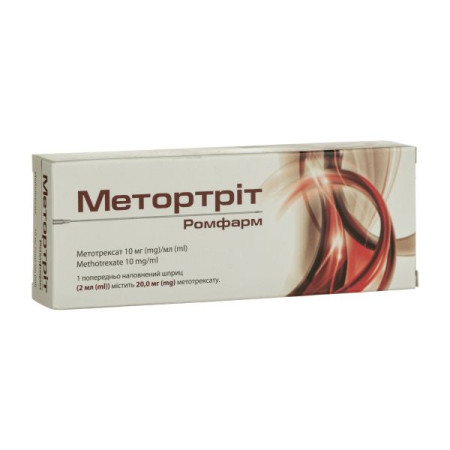Alcarnit solution for injection 200 mg/ml ampoule 5 ml No. 5

Instructions Alcarnit solution for injection 200 mg/ml ampoule 5 ml No. 5
Composition
active ingredient: levocarnitine;
1 ml of solution contains levocarnitine in terms of 100% substance – 200 mg;
Excipients: hydrochloric acid or sodium hydroxide, water for injection.
Dosage form
Solution for injection.
Main physicochemical properties: transparent, colorless or slightly yellowish solution.
Pharmacotherapeutic group
Amino acids and their derivatives. Levocarnitine.
ATX code A16A A01.
Pharmacological properties
Pharmacodynamics
Levocarnitine is a naturally occurring substance essential for energy metabolism in mammals. It has been shown that this substance facilitates the entry of long-chain fatty acids into cell mitochondria, thereby providing a substrate for oxidation and subsequent energy production. Fatty acids are used as an energy substrate in all tissues except the brain. In skeletal and cardiac muscles, fatty acids are the main substrate for energy production.
Primary systemic carnitine deficiency is characterized by low concentrations of levocarnitine in plasma, erythrocytes, and/or tissues. It has not been possible to determine which symptoms are associated with carnitine deficiency and which with primary organic acidemia, since the use of levocarnitine may exacerbate the symptoms of both pathologies. According to literature, carnitine is able to stimulate the excretion of excess organic or fatty acids in patients with disorders of fatty acid metabolism and/or specific organic acidopathies that bioaccumulate acyl-CoA esters.
Secondary carnitine deficiency may result from congenital metabolic disorders or iatrogenic factors such as hemodialysis. Levocarnitine may alleviate metabolic disorders in patients with congenital defects that lead to the accumulation of toxic organic acids. This effect has been demonstrated in the following conditions: glutaric aciduria type II, methylmalonic aciduria, propionic acidemia, and medium-chain fatty acyl-CoA dehydrogenase deficiency. In such patients, autointoxication occurs due to the accumulation of acyl-CoA compounds that disrupt intermediate metabolism. Further hydrolysis of the acyl-CoA compound to its free acid leads to acidosis, which can be life-threatening. Levocarnitine removes acyl-CoA by forming acylcarnitine, which is rapidly excreted from the body. Carnitine deficiency is defined biochemically as an abnormally low level of free carnitine in plasma, less than 20 μmol/L, one week after delivery, and may be associated with low concentrations in tissues and/or urine. In addition, this condition may be associated with an increase in
the ratio of acylcarnitine/levocarnitine concentrations in blood plasma (more than 0.4) or abnormally elevated acylcarnitine concentrations in urine. In premature infants and newborns, secondary deficiency is determined by the concentration of levocarnitine in blood plasma below the age-related norm.
Patients with end-stage renal disease (ESRD) on maintenance hemodialysis may have low plasma carnitine concentrations and an increased acylcarnitine/carnitine ratio due to reduced meat and dairy intake, decreased renal synthesis, and loss of dialysis fluid. Some clinical symptoms commonly seen in patients on hemodialysis, such as malaise, muscle weakness, cardiomyopathy, and cardiac arrhythmias, may be related to impaired carnitine metabolism.
In the course of studies using levocarnitine, it was shown that its administration to patients with TNN on hemodialysis leads to an increase in the concentration of levocarnitine in the blood plasma.
Pharmacokinetics
Plasma concentration profiles of levocarnitine following a slow 3-minute intravenous bolus of 20 mg/kg levocarnitine were described using a two-compartment model. After a single intravenous dose, approximately 76% of the levocarnitine dose was excreted in the urine within 0-24 hours. Using plasma concentrations uncorrected for endogenous levocarnitine, the mean half-life was 0.585 hours and the mean apparent terminal half-life was 17.4 hours.
The total clearance of levocarnitine (dose/area under the pharmacokinetic concentration-time curve (AUC), including endogenous background concentrations) averaged 4.00 L/hour.
Levocarnitine was not bound to plasma proteins or albumin in studies at any concentrations or in any organisms, including humans.
Although the efficacy of ALKARNIT in increasing carnitine concentrations in patients with CKD undergoing dialysis has been demonstrated, the effect of carnitine supplementation on the signs and symptoms of carnitine deficiency and on clinical outcomes in this population has not been determined.
Indication
For the emergency and long-term treatment of patients with inborn errors of metabolism leading to secondary carnitine deficiency.
For the prevention and treatment of carnitine deficiency in patients with end-stage renal disease undergoing dialysis.
Contraindication
Hypersensitivity to any components of the drug.
Interaction with other medicinal products and other types of interactions
Simultaneous use of glucocorticoids leads to the accumulation of levocarnitine in body tissues (except the liver). Other anabolic agents enhance the effect of the drug.
Very rare cases of increased international normalized ratio (INR) have been observed in patients receiving coumarin anticoagulants concomitantly with levocarnitine (see sections 4.4 and 4.8). INR or other appropriate coagulation test should be performed weekly until stable, and monthly thereafter, in patients receiving such anticoagulants concomitantly with levocarnitine.
Application features
General
The safety and efficacy of oral levocarnitine have been evaluated in patients with renal insufficiency. Prolonged administration of high doses of oral levocarnitine to patients with severe renal impairment or patients with CKD on dialysis may result in the accumulation of the potentially toxic metabolites, trimethylamine (TMA) and trimethylamine-N-oxide (TMAO), since these metabolites are normally excreted in the urine.
Levocarnitine improves glucose absorption, so the use of the drug in patients with diabetes mellitus who are treated with sugar-lowering drugs may lead to hypoglycemia. The level of glucose in the blood plasma in such cases must be regularly monitored for timely correction of therapy.
Very rare cases of increased INR have been observed in patients who were simultaneously taking levocarnitine and coumarin anticoagulants (see sections “Interaction with other medicinal products and other types of interactions” and “Adverse reactions”).
Sodium
This medicinal product contains less than 1 mmol (23 mg) sodium/dose, i.e. essentially sodium-free.
Use during pregnancy or breastfeeding
Pregnancy
Reproductive studies have been conducted in rats and rabbits at doses 3.8 times the human dose based on surface area and have revealed no evidence of impaired fertility or harm to the fetus due to ALKARNITE.
Because animal reproduction studies are not always predictive of human response, use should be limited to clearly defined indications. However, there are no adequate and well-controlled studies in pregnant women.
Breastfeeding period
Levocarnitine has not been specifically studied during breastfeeding. Levocarnitine is a normal component of breast milk.
Considering the serious consequences of carnitine deficiency for a pregnant woman, the risk to the mother of interrupting levocarnitine treatment is considered greater than the theoretical risk to the fetus if treatment is continued.
Ability to influence reaction speed when driving vehicles or other mechanisms
Unknown.
Method of administration and doses
ALKARNIT is administered intravenously slowly over 2–3 minutes.
Metabolic disorders
The recommended dose is 50 mg/kg given as a slow bolus injection over 2-3 minutes or as an infusion. Often, patients with severe metabolic crisis are given a loading dose, after which an equivalent dose is required over the next 24 hours. The drug should be administered by infusion or intravenous injection every 3 or 4 hours and in no case less than 6 hours apart. It is recommended that all subsequent daily doses be in the range of 50 mg/kg or as therapeutically necessary. The maximum permissible dose is 300 mg/kg.
It is recommended that plasma carnitine concentrations be achieved before starting this parenteral therapy. Weekly and monthly monitoring is also recommended. This monitoring should include blood chemistry, vital signs,
indicators of carnitine concentration in blood plasma (the concentration of free carnitine in blood plasma should be from 35 to 60 μmol/l) and general clinical condition.
Patients with TNN on hemodialysis
The recommended initial dose is 10-20 mg/kg body weight as a slow 2-3 minute bolus injection into the venous circulation after each dialysis session. The initiation of therapy may be due to pre-dialysis trough concentrations of levocarnitine in the blood plasma that are below normal (40-50 μmol/l). Dose adjustments should be made based on pre-dialysis levocarnitine concentrations, and downward dose adjustments (e.g. to 5 mg/kg after dialysis) may be made as early as the third or fourth week of therapy.
Hemodialysis – maintenance therapy
After a loading course of intravenous administration of the drug, a maintenance dose of 1 g of levocarnitine per day orally should be used. On the day of dialysis, levocarnitine should be administered intravenously at a dose of 1 g immediately after the end of the next session.
ALKARNITE is compatible and stable when mixed with parenteral solutions of 0.9% sodium chloride or lactated Ringer's in concentrations from 250 mg/500 mL (0.5 mg/mL) to 4200 mg/500 mL (8.0 mg/mL).
Children
The drug should be used in children from the first day of life, including premature babies.
Overdose
There is no confirmed data on the toxicity of levocarnitine in overdose. Large doses of the drug may cause diarrhea.
Treatment. Take measures to remove the drug from the digestive tract if taken orally. Provide symptomatic and supportive therapy. Levocarnitine is readily removed from plasma by dialysis. No life-threatening cases of overdose have been reported.
Side effects
All of the following adverse reactions occurred very rarely.
Gastrointestinal tract
Various mild gastrointestinal disturbances have been observed with long-term oral levocarnitine administration, including transient nausea and vomiting, abdominal pain, and diarrhea. Patients have also developed a characteristic body odor. Reducing the dose often reduces or eliminates gastrointestinal symptoms and body odor.
Blood and lymphatic system disorders
In very rare cases, an increase in INR has been observed in patients (see sections “Interaction with other medicinal products and other types of interactions” and “Special instructions for use”).
Neurological reactions
Convulsions have been reported in patients with or without prior seizure activity when levocarnitine was administered either orally or intravenously. In patients with pre-existing seizure activity, an increase in seizure frequency and/or severity has been reported.
Hypersensitivity reactions
There have been official reports of serious hypersensitivity reactions, including anaphylaxis, laryngeal edema, and bronchospasm, following the administration of levocarnitine, mainly in patients with end-stage renal disease undergoing dialysis. Some reactions have occurred within minutes of intravenous administration of levocarnitine.
If a severe hypersensitivity reaction occurs, ALCARNITE should be discontinued and optimal medical management initiated. The risks and benefits of re-administration of ALCARNITE to individual patients after a severe reaction should be considered. If a decision is made to re-administer the drug, patients should be monitored for signs and symptoms of a hypersensitivity reaction.
Tolerability should be carefully monitored during the first week of administration and after any dose increase. Intravenous administration of levocarnitine is usually well tolerated.
Expiration date
2 years.
Storage conditions
Store in original packaging at a temperature not exceeding 25 ° C. Keep out of the reach of children.
Incompatibility
Do not mix with other medicines in the same container.
Packaging
5 ml in an ampoule, 5 ampoules in a blister, 1 or 2 blisters in a pack or 100 ampoules in a pack.
Vacation category
According to the recipe.
Producer
Private Joint-Stock Company "Lekhim-Kharkiv".
Location of the manufacturer and address of its place of business
Ukraine, 61115, Kharkiv region, Kharkiv city, Severyna Pototskoho street, building 36.
There are no reviews for this product.
There are no reviews for this product, be the first to leave your review.
No questions about this product, be the first and ask your question.









